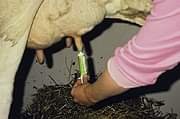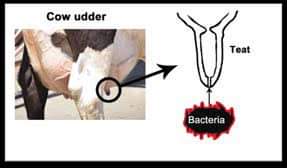INTRAMAMMARY INFUSION PROCEDURE IN COWS FOR MASTITIS & DRY COW THERAPY
Introduction:
Mastitis – inflammation of the mammary gland – is caused by several species of bacteria, fungi, mycoplasmas and algae. Subclinical mastitis are those for which no visible changes occur in the appearance of milk or the udder, but milk production decreases, somatic cell count (SCC) increases, pathogens are usually present in the secretion, and the milk composition is altered .Many intramammary infections (IMI) prove to be persistent for a considerable length of time resulting in high SCC and decreased milk yield. Any IMI may lead to development of clinical mastitis (CM) and spread of mastitis pathogens from infected to uninfected mammary quarters within the herd . Antibacterial therapy is an important part of a mastitis control program in dairy cattle . Treatment of many subclinical IMIs is often postponed until the dry period or until a clinical flare-up is observed. However, with the increasing demand to produce milk with a low bulk tank somatic cell count (BTSCC), it may not be economically justifiable to wait until dry-off .Thus, there is an interest in adopting effective treatment strategies.
Intramammary infection (mastitis) is the most common reason for the use of antimicrobials in dairy cows . Antimicrobials have been used to treat mastitis for more than fifty years, but consensus about the most efficient, safe, and economical treatment is still lacking. The concept of evidence-based medicine has been introduced to veterinary medicine and should apply also to treatment of mastitis. The impact on public health should be taken into account as dairy cows produce milk for consumption.
Mastitis treatments and dry cow therapy are normally administered intramammary. In some cases of mastitis, antibiotic injections are also needed. This post will look at the correct method of administering intramammary products.
Cows can be treated at two different stages in lactation and in three ways: —-
• Lactating cow therapy
• Dry cow therapy.
Different routes of administration ————–
• Intramammary treatment
• Parenteral treatment (by injection)
• Oral therapy.
What is the correct procedure for intramammary infusion?————-
- Antibiotic treatments
- Dry cow therapy
- Non-Antibiotic dry cow therapy.
- Antibiotic treatment —————-
• Before infusion, the udder should be milked out completely
• Teat/orifice should be thoroughly cleaned and disinfected with a sterile alcohol wipe
• Avoid contamination of the syringe nozzle
• Break the top of the cap
• Gently insert (length depends on tube design)
• Infuse( squeeze) the total content of the syringe into the quarter
• Disperse the product by gentle massage of the teat
• Dip with iodine solution
• Monitor cow and write down details in the animal medicine book
• Observe the milk withdrawal period. - Dry cow therapy ——————-
• Antibiotics given to cows as they dry off
• Slow release antibacterial activity
• Antibiotic kills bacteria present at drying off period
• All quarters treated • Prevents new infections occurring during the dry period
• Procedure same as for the antibiotic treatment.
- Non-Antibiotic dry cow therapy (also known as teat sealant)———- • Forms a physical barrier in the teat
• Prevents new intramammary infections throughout the dry period
• Reduces the incidence of subclinical mastitis in cows at calving
• Clean and dry teats
• Clean the end of the teat to remove any contaminated skin, dirt or manure
• Disinfect the far teats before the near teats, to avoid accidental contamination of previously disinfected teats
• Insert the teat sealant syringe nozzle into the teat canal and inject all contents
• Use one complete syringe per quarter. Do not massage. It must remain in the teat to be effective
• Nearest teats should be treated first to minimize contamination of teats that have not been treated
• After treating each cow, mark the cow so others can tell she has been dried off. Then dip each teat with a quality teat dip.
USE PROPER INFUSION PROCEDURES—-
Equipment needed:
• 70% alcohol (isopropyl rubbing alcohol)
• Cotton balls or gauze pads
• Paper towels
• Prepared, single-infusion antibiotics tubes
• Germicidal teat dip
• Leg band or other means of temporary identification
• Permanent record sheet
Infusion Procedures
Following proper infusion procedures is a key component of the dry cow therapy program.
Teats must be cleaned and sanitized before infusing antibiotics into a quarter. Without proper preparation, organisms present on the teat end may be forced into the udder and result in an infection more severe than the one for which treatment was intended.
The following steps should be adhered to closely anytime intramammary infusion products are administered.

1.Udder should be clean and dry. Be sure quarters are completely milked out.
- Scrub the end of each teat with a gauze pad or cotton ball soaked in 70% alcohol. Allow alcohol to dry on skin for 30 seconds. Sanitize teats farthest away first, then nearest teats.
- Remove the cap from the infusion tube without contaminating the tip. Note the recommended partial insertion depth on tip.
- Partially insert the cannula into the teat end. Infuse nearest teats first, then teats farthest away.
- Gently infuse the contents of the infusion tube.
- Dip or spray teats in an approved germicidal, post-milking teat dip.
- Identify the cow to avoid contaminating the milk supply. Follow withdrawal recommendations.
- Record treatment information in permanent records.
How to infuse the intramammary tube————–
- Put clean gloves on.
- Completely strip out the quarter you are treating.
- If the teat is visibly dirty, wash with clean warm water and dry thoroughly.
- Pre-dip or use a fast acting disinfectant on the teat, leave on for 30 seconds and wipe dry.
- Wipe the teat with cotton wool and surgical spirit. Don’t take the top off the tube until you have done the above steps.
- Insert the tube halfway into the teat end and infuse.
- Apply post-milking disinfection to the teat.
- Keep the cow in a clean yard for at least 30 minutes afterwards to allow the teat canal to close.
- Record the treatment in the appropriate farm records.
NB-
An important question regarding the treatment of mastitis is whether the antimicrobial should accumulate in the milk or in the udder tissue . The target site may depend on the causative agent: streptococci are known to remain in the milk compartment, but S. aureus penetrates udder tissue and causes deep infection . The most common route of administration of antimicrobials in mastitis is the IMM route. The advantages of this route are high concentrations of the substance achieved in the milk and low consumption of the antimicrobial as the drug is directly infused into the diseased quarter. For example, concentration of penicillin G in milk after IMM administration is 100-1000 times as high as the concentration after systemic (parenteral) administration . A disadvantage of the IMM administration is uneven distribution throughout the udder and the risk of infecting the quarter when infusing the product via the teat canal. Efficacy of IMM treatment varies according to the causative pathogen, with the best therapeutic response
The systemic route of administration has been suggested to be more efficient than IMM for the treatment of clinical mastitis as antimicrobials theoretically have better penetration of the udder tissue by this route . However, it is difficult to attain and maintain therapeutic concentrations in milk or udder tissue following systemic administration.
Dr.Ajeet Singh, Livestock consultant, Gorakhpur
Reference-On request



